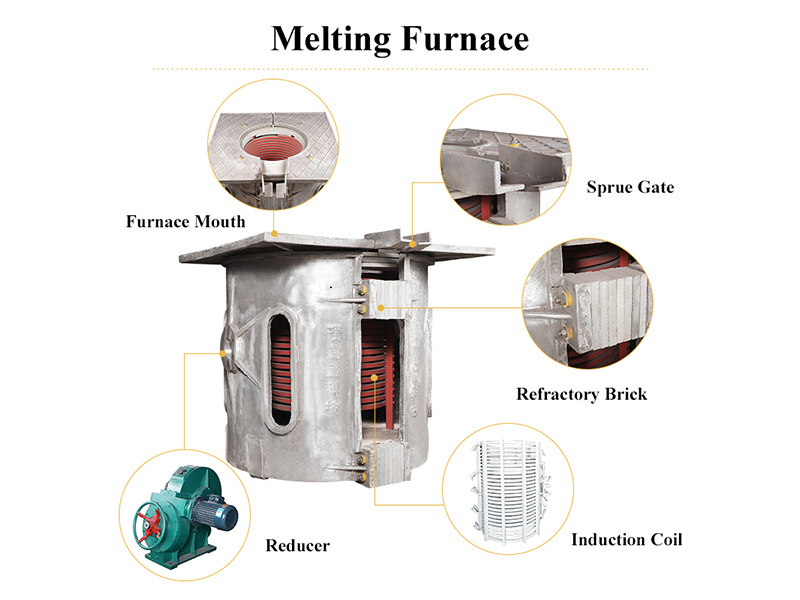Case Studies: Successful Implementations of Scrap Melting Induction Furnaces
Release time:
2025-07-24
Introduction to Scrap Melting Induction Furnaces In the evolving landscape of industrial manufacturing, scrap melting induction furnaces are revolutionizing the way metal recycling is handled. These furnaces utilize electromagnetic induction to melt ferrous and non-ferrous metals efficiently and sustainably. With the increasing demand for recycled materials, the adoption of induction furnaces is

Introduction to Scrap Melting Induction Furnaces
In the evolving landscape of industrial manufacturing, scrap melting induction furnaces are revolutionizing the way metal recycling is handled. These furnaces utilize electromagnetic induction to melt ferrous and non-ferrous metals efficiently and sustainably. With the increasing demand for recycled materials, the adoption of induction furnaces is gaining momentum. This article delves into several case studies that highlight successful implementations of scrap melting induction furnaces.

Understanding the Technology Behind Induction Furnaces
Induction furnaces operate on the principle of electromagnetic induction, where an alternating current passes through a coil, generating a magnetic field that induces heat within the metal scrap. This method offers several advantages over traditional melting techniques, including faster melting times, improved energy efficiency, and enhanced metal quality.
Benefits of Scrap Melting Induction Furnaces
The benefits of using scrap melting induction furnaces are multifaceted:
- Energy Efficiency: Induction melting requires significantly less energy compared to conventional methods.
- Reduced Emissions: These furnaces produce fewer greenhouse gases, aligning with global sustainability goals.
- Higher Melting Rates: Induction furnaces can achieve faster melting times, improving production throughput.
- Improved Metal Quality: The controlled melting environment minimizes contamination, enhancing the quality of the final product.
Case Study 1: Automotive Parts Manufacturer
A leading automotive parts manufacturer implemented a scrap melting induction furnace to process aluminum scrap. Prior to this shift, the company relied on traditional melting methods, which were not only energy-intensive but also produced significant waste.
Challenges Faced
The manufacturer faced challenges such as:
- High operational costs due to energy consumption
- Longer production cycles affecting timely delivery
- Inconsistent metal quality leading to defects
Implementation of Induction Furnace
The company invested in a state-of-the-art induction furnace specifically designed for melting aluminum. The new system allowed for precise temperature control and faster melting times. Additionally, it was integrated with a scrap sorting system to enhance the quality of the input materials.
Results Achieved
Post-implementation, the manufacturer reported:
- 30% reduction in energy costs
- 40% increase in production rates
- Improved product quality with a 20% decrease in defects
This case study exemplifies the transformative impact that scrap melting induction furnaces can have on manufacturing operations.
Case Study 2: Metal Recycling Facility
A prominent metal recycling facility turned to induction melting technology to enhance its operations. The facility focused on processing a wide range of scrap metals, including copper, brass, and stainless steel.
Initial Challenges
The facility encountered several hurdles:
- Inconsistent melting performance due to varying scrap quality
- Excessive energy consumption leading to elevated operational costs
- Environmental concerns regarding emissions from traditional methods
Induction Furnace Adoption
The facility opted for a multi-purpose induction furnace capable of handling various types of scrap. This flexibility allowed for real-time adjustments based on the scrap quality, leading to optimized melting cycles.
Outcomes and Impact
After the integration of the induction furnace, the facility noted:
- Significant reduction in energy consumption by approximately 25%
- Increased throughput by 50% due to faster melting capabilities
- Lower emissions, contributing to a greener operational footprint
This success story underscores the versatility of scrap melting induction furnaces in various industrial applications.
Case Study 3: Foundry Operation
A traditional foundry operation sought to modernize its melting process to keep pace with industry standards. The move towards adopting induction melting technology was driven by the need for improved efficiency and reduced environmental impact.
Foundry's Initial Situation
The foundry faced challenges, including:
- High operational costs associated with traditional melting methods
- Inconsistent production quality
- Inability to meet growing demand for recycled materials
Implementation of Induction Technology
By installing a new induction furnace, the foundry was able to achieve a more controlled melting process. The induction furnace's precise temperature management allowed for the melting of high-quality alloys without compromising material integrity.
Results and Benefits
Following the implementation, the foundry experienced:
- 35% decrease in energy costs
- Enhanced product consistency, resulting in fewer rejects
- Increased capacity to handle a wider variety of scrap materials
This case illustrates the significant advancements that scrap melting induction furnaces bring to foundry operations.
Case Study 4: Heavy Machinery Manufacturer
A heavy machinery manufacturer recognized the need to optimize its melting operations. The company faced challenges in recycling metal components efficiently.
Pre-Implementation Challenges
The manufacturer dealt with:
- High costs of raw materials due to reliance on virgin metal
- Increased waste generation from ineffective melting processes
- Regulatory pressures to reduce emissions
Intervention with Induction Furnaces
To address these issues, the manufacturer adopted a high-capacity induction melting system. The furnace was designed to handle large volumes of scrap metal, enabling continuous operation and improved efficiency.
Transformative Results
After implementing the induction furnace, the manufacturer saw:
- A 45% decrease in raw material costs due to increased recycling
- A 30% reduction in overall waste generation
- Compliance with environmental regulations, resulting in fewer fines and enhanced corporate responsibility
This case highlights how the adoption of advanced melting technologies can lead to significant operational improvements in heavy manufacturing.
Case Study 5: Innovative Start-Up in Metal Recycling
An innovative start-up focused on metal recycling sought to disrupt the industry by utilizing state-of-the-art induction furnaces. The company aimed to produce high-quality recycled metals for various applications.
Challenges During Early Operations
The start-up encountered:
- High initial investments in technology
- Challenges in sourcing quality scrap materials
- Need for rapid scaling to meet market demand
Adopting Induction Furnace Technology
The start-up invested in compact induction melting furnaces that offered scalability and efficiency. This technology allowed for quick adjustments in production based on incoming scrap quality.
Achievements and Industry Impact
Within a year of operation, the start-up achieved:
- A 50% reduction in energy costs
- Production of high-quality recycled metal with minimal impurities
- Establishment as a leader in innovative recycling solutions
This case demonstrates the potential of induction melting technology in fostering new business models in the recycling industry.
The Future of Scrap Melting Induction Furnaces
The future of scrap melting induction furnaces looks promising as industries increasingly adopt sustainable practices. Continuous advancements in technology are expected to yield even greater efficiencies and capabilities, driving the evolution of metal recycling further.
Emerging Trends and Innovations
Some key trends influencing the future of induction furnaces include:
- Integration of Industry 4.0 technologies for enhanced automation and data analytics
- Development of furnaces with higher capacity and flexibility
- Improved materials and designs to further enhance energy efficiency
FAQs About Scrap Melting Induction Furnaces
1. What are the primary advantages of using scrap melting induction furnaces?
Scrap melting induction furnaces offer energy efficiency, reduced emissions, faster melting times, and improved metal quality.
2. How do induction furnaces improve metal recycling processes?
They provide a controllable melting environment that minimizes contamination and optimizes the melting of various scrap materials.
3. Can induction furnaces handle different types of metals?
Yes, induction furnaces can be designed to process both ferrous and non-ferrous metals, including aluminum, copper, and stainless steel.
4. What is the typical energy savings achieved with induction melting?
Energy savings can vary between 25% to 50% compared to traditional melting methods, depending on the specific application and material used.
5. How does using induction furnaces contribute to sustainability?
Induction furnaces produce fewer emissions, reduce waste, and promote the recycling of metals, aligning with global sustainability initiatives.
Conclusion
The successful implementation of scrap melting induction furnaces across various industrial sectors illustrates their significant impact on efficiency, sustainability, and quality of metal recycling. Through these case studies, it is evident that investing in advanced melting technology not only drives operational improvements but also aligns with broader environmental goals. As industries continue to prioritize sustainability and efficiency, the adoption of scrap melting induction furnaces will undoubtedly play a pivotal role in shaping the future of metal recycling.



